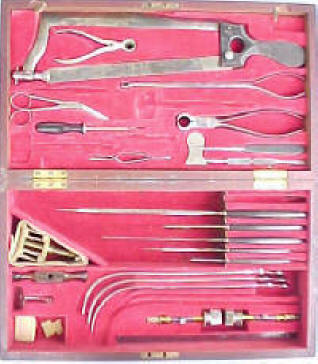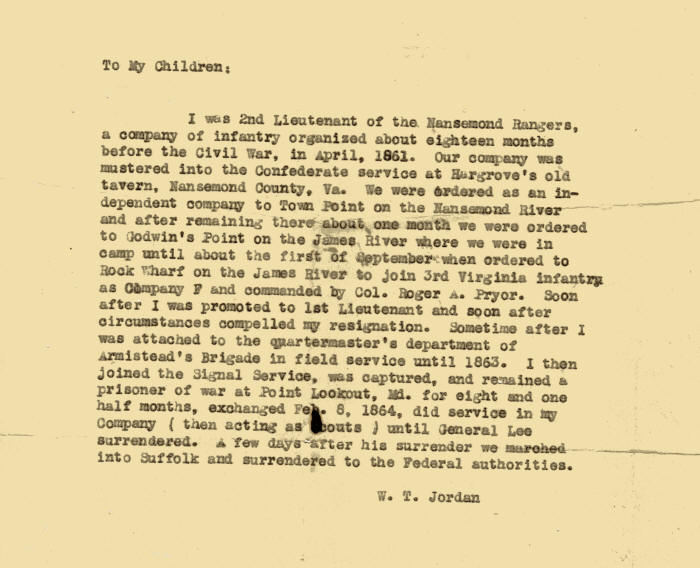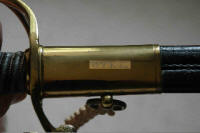William Turner Jordan, M.D.,
CSA
A
Hernstein surgery set, which belonged to Dr. Jordan' is
part of this collection.
Click
here
to see the detailed display of the set. |
 |
Below is a note sent to the children of W. T.
Jordan regarding his whereabouts during the War.
Jordan was born
11-13-1835 in Nansemond, County, Virginia and died 3-14-1922, note
courtesy of family member, John Litchfield.
Click image to enlarge

William Turner Jordan, 3rd
Virginia Infantry, Company F, 1st Lieutenant, transferred to an
Independent Scout Unit.
Jordan was born November 13, 1835, the son of William Edmund and Martha
J. D. Gary Jordan. He attended University of
Virginia medical school from 1855 to 1857. He married Amanda Charlotte
Arthur (1841-1900), the daughter of James S. and
Charlotte Ward Arthur in 1861. Jordan was a physician and farmer in
Bellsville, Virginia. Around 1907, he wrote an historical
sketch of the farms and their owners in the Lower Parish of Nansemond
County, which has been published by the
Nansemond-Suffolk Historical Society. Jordan died March 14, 1922 and was
buried in Cedar Hill Cemetery, Block F, Lot 59.
In 1892, at age 62, Nansemond census:
Jordan, William T. 2 Lt.
F 3rd Va. Inf. 4-25-1861
(Nansemond County Civil
War Veterans: This file is the product of many hours by Bruce
Saunders and Marion Joyner Watson. We hope it is useful to many.
This page may be freely copied, linked to, or used for any
non-commericial purpose. It may not be copied for any commercial
purpose. Property of Southampton County Historical Society.
copyright 1998)
William Turner Jordan
was a prisoner of war at Point Lookout Prison in Maryland in 1864.
He is listed in the archives as one of the doctors among the prisoners:
Point Lookout was the largest and one
of the worst Union prisoner-of-war camps, established on August 1, 1863.
It was located at the extreme tip of St. Mary's County, on the long,
low, and barren peninsula where the Potomac River joins Chesapeake Bay.
The prison's official name was Camp Hoffman but it was hardly ever used.
The site was originally leased
to the Federal Government in June 1862, and quickly became a major
government installation. The site was comparatively isolated and easily
protected. At the extreme end of the peninsula, near the lighthouse, a
1,400-bed hospital complex was built with 20 buildings arranged in a
circle, a large wharf to receive supplies and the wounded soldiers that
came in from battlefields; a number of storehouses and stables; laundry
and dining facilities; and additional quarters for officers, doctors,
surgeons, and Union troops. The hospital became one of the largest and
busiest medical facilities in the Union's service. Before long, the
prison became the most populated and largest Union prison, because it
was so close to the battlefields on the Eastern Theater.
Point Lookout Prison Camp for Confederates from
1863 to 1865 in the state of Maryland. Point Lookout housed over 52,000
Southerners, with a death count of over 14,000.
There was much animosity between the prisoners and the guards, who were
mostly black troops. One Confederate who had managed to purchase his
freedom from the prison reported that "murder was not only not scrupled
at, but opportunities sought for its commission by the guards, who are
known to have been offered by the officer of the day as much as $10 and
$15 apiece for every prisoner they could shoot in the discharge of their
duty."
Point Lookout CSA Doctors
Dr.John Wesley Wood, 12th AL
Dr. Hugh C. Martin, Co. C 2nd MD Cav.
Dr. J. N. Jones, Isle of Wight Country, VA
Dr. John Ball Waring, 27th SC Inf. Co. A
Dr. John Smyly, 4th SC Cav. Co. G
Lt. William Turner Jordan, M.D., 3rd VA Inf. Co. F
In the letter to his children above,
Jordan says he was then acting as 'scouts' in 1864.
This is a citation of the Confederate
Signalmen and Telegraph Operators from Virginia:
Jordan, William T.: Pvt. Enl.
2nd Co. Petersburg 9-3-1863, Present until captured Isle of
Wright Co. 6-6-1864. Sent to Ft. Monroe. Transferred to
Point Lookout. Exchanged 2-15-1865. Paroled Dist. of
Eastern Va. 4-22-1865. Res. Nansemond County.
This is a citation in the:
UNION CORRESPONDENCE, ORDERS, AND RETURNS RELATING TO OPERATIONS IN
LOUISIANA AND THE TRANS-MISSISSIPPI STATES AND TERRITORIES, FROM
SEPTEMBER 1, 1864, TO OCTOBER 15, 1864.
HDQRS. MILITARY DIVISION OF WEST
MISSISSIPPI,
OFFICE OF THE CHIEF SIGNAL OFFICER,
New Orleans, September 30, 1864.
Maj. Gen. E. R. S. CANBY,
Comdg. Mil. Div. of West Miss., New Orleans, La.:
GENERAL: I have the honor to submit to your consideration a statement of
the information received at this office this 30th day of September,
1864, from the following sources: A report from Bernard Norton, scout,
mouth of White River, September 24; the statement of W. W. Aber,
Vicksburg, Miss., September 20; the statement of
W. T. Jordan, Vicksburg, Miss.
(Miss.??? must be a mistake),
September 22. Mr. Norton states that General Price crossed the Arkansas
on the 7th instant, at Dardanelle and Galls Rock, with 8,000 men, 12
guns, and 400 wagons. He is moving in the direction of Missouri. North
of White River, at Jacksonport, Generals McCray and Shelby are moving in
the same direction, with a force estimated at 6,000 cavalry. There is no
force at Hot Springs. Colonel Logan is at Princeton, with 600 cavalry.
Captain Cooper is at the North Fork of the Saline, with three companies
of cavalry. Colonel Harrison's command, the Third Louisiana Cavalry, his
own regiment, Colonel Capers' regiment, and Colonel McNeill's regiment.,
were at Oak Ridge, La., on the 13th instant, but were under orders to
move into Arkansas to re-enforce Marmaduke, or to do picket duty near
Monticello while the other troops move into Missouri. His force is
estimated from 1,500 to 2,500. On the 13th Walker's and Polignac's
divisions were still at Monroe, La., but under marching orders for the
north. Price's army of invasion is said to be 20,000 or 25,000 strong.
Captain Lee's guerrillas, seventy-five or eighty strong, on
the 14th instant, were at Bone Wade's plantation, four miles above
Floyd, La.
I am very respectfully, your obedient servant,
FRANK W. MARSTON,
Major, Signal Corps, U.S. Army, Commanding.
The Signal Corps in the
Confederate States Army Signal Corps, was a much smaller group of
officers and men, using similar organizations and techniques as
their Union opponents. Although both services had an implicit
mission of battlefield observation, intelligence gathering, and
artillery fire direction from their elevated signal stations, the
Confederate Signal Corps also included an explicit espionage
function.
The Confederate Signal Corps perform duties and utilized equipment
very similar to their Northern counterparts, with some exceptions.
Electric telegraphy was not used in tactical battlefield
communications due to shortages of telegraph wire and trained
operators. Their aerial telegraphy was performed with similar flags,
but with slightly modified codes and movements from the Myer
methods. Unlike the Union Signal Corps, however, the Confederate
Signal Corps also was chartered to conduct espionage for the South.
(Both services provided valuable battlefield intelligence, and
sometimes artillery fire direction, from their elevated observation
points, but the Confederate corpsmen performed undercover missions
behind enemy lines as well.) Acting as the Secret Service of the
Confederacy, the corps administered the Secret Line, an information
network that ran between Richmond and the North and extended into
Canada. It is because of its clandestine nature that much of the
work of the Confederate Signal Corps is lost to history. Many of its
records were burned in the fall of Richmond and in a subsequent fire
at Norris's home, which claimed his personal papers.
___________________
This is information from the AMA deceased
physicians data relative to William Turner Jordan:
Name: William Turner Jordan
Death date: Mar 13, 1922
Place of death: Driver, VA
Birth date: 1835
Type of practice: Allopath
States and years of licenses: VA
Places and dates of practices: Driver, VA, 1859
Medical school(s): New York University Medical College, New
York: Univ. of City of New York Med. Dept., 1859, (G)
Journal of the American Medical Association Citation:
78:1145
(Note: there is no mention of
Jordan attending the Univ. of Virginia in the AMA
citation and I have not been able to find him listed as a
student at Virginia?)
(Note: Driver, Virginia, was
originally named
"Persimmon Orchard", Driver was once located in the former
Nansemond County between the former
town of Suffolk and the
City of Portsmouth, which was itself
was located in the former
Norfolk County.)
(The 1859 Alumni Report of The University of
the City of New York, Medical Department shows W.T. Jordan
as a graduate in that year, but there is no attribute to him
as having served as a surgeon in the Civil War.)
The fact he graduated in 1859, leaves
a large amount of time until the beginning of the Civil War.
The question is why didn't he serve as a medical officer
instead of an infantry officer? And why did he resign
his commission and then later rejoin as a private in the
signal service?
Nansemond County Civil War Veterans:
William Turner Jordan
3rd Virginia Infantry, Company F, 1st Lieutenant,
transferred to an Independent Scout Unit.
Jordan was born November 13, 1835, the son of William Edmund and
Martha J. D. Gary Jordan. He attended University of
Virginia medical school from 1855 to 1857. He married Amanda Charlotte Arthur (1841-1900), the daughter of James S. and
Charlotte Ward Arthur in 1861. Jordan was a physician and farmer
in Bellsville, Virginia. Around 1907, he wrote an historical
sketch of the farms and their owners in the Lower Parish of
Nansemond County, which has been published by the
Nansemond-Suffolk Historical Society. Jordan died March 14, 1922
and was buried in Cedar Hill Cemetery, Block F, Lot 59.
A Record of Farms and Their Owners in the Lower
Parish of Nansemond County, Virginia by Dr. William Turner Jordan
(1835-1922)
"A Record of Farms and Their
Owners in Lower Parish of Nansemond County, Virginia." by
William Turner Jordan, M.D. (1835 - 1922); Published by Suffolk-Nansemond
Historical Society, Suffolk, Virginia; First Edition - 1968;
Second Edition - 1977. From the introduction - "Beginning in
1907, Dr. Jordan, whose ancestors landed at Jamestown and who
served the people of the Driver community as their friend and
family physician for more than fifty years, recorded, as time
would permit, both local history as he knew it and as it was
told to him by those much older."
The plot thickens, it seems Dr. Turner attended
the University of Virginia Medical School from 1855 to 1857, then went
to the University of the City of New York in 1858-1859.
Courtesy of Dr. T. Hambrecht:
(citation in Wallace, L. A. [1986] 3rd
Virginia Infantry. 2nd edition, H. E. Howard, Inc.,
Lynchburg, VA. p.93)
JORDAN, WILLIAM TURNER: born Nov 13, 1835; physician;
enl. Ap.21, 1861, at Hargroves Tavern; 2nd Lt., Co F.
Resigned, Sept. 17, 1861. Died Mar. 14, 1922. Buried in
Cedar Hill Cem. Suffolk.
|
W.T. Jordan's engraved Infantry saber (not
a medical staff sword), courtesy of family member, John Litchfield. |

 |
The 3rd Virginia Volunteer
Infantry Regiment was an
infantry regiment raised in Virginia for service in the Confederate
States Army during the American Civil War. It fought mostly with the
Army of Northern Virginia.
The 3rd Virginia was organized at Portsmouth, Virginia, in 1856 with
volunteer companies attached to the 7th Regiment Virginia Militia.
It entered Confederate service during July, 1861. Its members were
from Portsmouth and Petersburg, and the counties of
Nansemond,
Dinwiddie, Surry, Isle of Wright, Southampton, and Halifax.
Three companies were in the fight at Big Bethel, then the regiment
was assigned to General Colston's,
Pryor's,
Kemper's, and W.R. Terry's Brigade. It fought with the Army of
Northern Virginia from Williamsburg to Gettysburg except when it was
detached to Suffolk with Longstreet. Later it was active in the
conflicts at Plymouth, Drewry's Bluff, and Cold Harbor, the
Petersburg siege south and north of the James River, and the
Appomattox Courthouse Campaign.
This unit totaled 550 men in April, 1862, and reported 97 casualties
during the Seven Days' Battles, 19 in the Maryland Campaign, and 11
at Fredericksburg. Of the 332 engaged at Gettysburg, more than
thirty-five percent were disabled. Many were captured at Five Forks
and Sayler's Creek, and only 1 officer and 60 men surrendered in
April, 1865.
The field officers were Colonels Joseph Mayo, Jr. and
Roger A. Pryor;
and Lieutenant Colonels Alexander D. Callcote, William H. Pryor, and
Joseph V. Scott.
________________________
In the spring of
1863, Armistead
and his brigade took part in a foraging expedition to southeastern
Virginia and as a result missed the Chancellorsville Campaign
(1863).
On the third and final day of Gettysburg, Pickett's division, which
up to then had been held in reserve, was chosen to spearhead Lee's
major attack against the center of the Union line. Armistead's
brigade supported the division's front. With his hat on the tip of
his raised sword, he led his brigade on foot across the open ground
and into the chaotic fight on Cemetery Ridge. The brigade reached
the Union line, commanded in part by Hancock, but went no farther.
Armistead had just placed his hand on a Union cannon when he was
struck by a volley of rifle fire. While lying badly wounded, he
asked to see Hancock, but Hancock's command responsibilities and his
own wounds prevented it.
Instead, Armistead was carried to a nearby Union field hospital
where he died on July 5 from a combination of blood loss and
exhaustion
September 6, 1862 - Lewis A.
Armistead is assigned to duty as provost marshal of the Confederate
Army of Northern Virginia. He serves in that role during the
Maryland Campaign.
July 3, 1863 - Lewis A. Armistead leads his brigade in the attack
known as Pickett's Charge at the Battle of Gettysburg. Armistead and
his men reach the Union line, commanded by his old army friend Union
general Winfield Scott Hancock, but the attack fails and Armistead
is struck down by a volley of rifle fire and taken to a nearby Union
field hospital.
July 5, 1863 - Two days after he is wounded during what became known
as Pickett's Charge in the Battle of Gettysburg, Lewis A. Armistead
dies in a Union field hospital.
____________________
2014 update on Dr. Jordan's home:
The present owners (Jeff and Sara
Johnson) of the house where Dr. Jordan lived in Virginia graciously
sent follow-up details and photos of the house and grounds.
I've included their comments and the photos below:
The house
is located just outside the town of Driver in old Nansemond
County. The Jordan family operated a mill on the property
pre-Civil War and the foundation for the mill still exist on our
neighbors property. We have one of the mill stones in our front
yard which has been used as a well cap for as long as anyone can
remember. The Jordan property (known as Jordan's Mill Hill) was
eventually sold off after his death (date of sale unclear) and
parceled out over the years but the house has survived mostly in
its original condition. Locals refer to the property as the old
Whedbee farm.
Only two of the original outbuildings have survived the years,
one which was an old wood smoke house we now use as a shed and
an old crumbling brick pump house. We know that Dr. Jordan
operated his practice out of the house (we think in a1907
addition) and that for a time the house was also used as the
"county court house" after a fire at Hargrove's Tavern.
The current house did not exist on the property during the
American Civil War, but relics of the conflict have been found
in the yard .
It's interesting that the info from genealogical records and on
your website states that Dr. Jordan is buried in Cedar Hill
Cemetery in Suffolk.
|
|